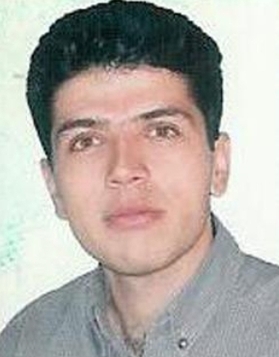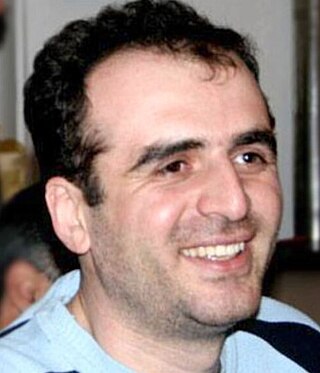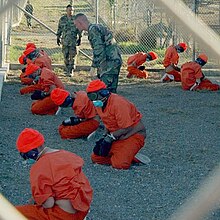
Solitary confinement is a form of imprisonment in which an incarcerated person lives in a single cell with little or no contact with other people. It is a punitive tool used within the prison system to discipline or separate incarcerated individuals who are considered to be security risks to other incarcerated individuals or prison staff, as well as those who violate facility rules or are deemed disruptive. However, it can also be used as protective custody for incarcerated individuals whose safety is threatened by other prisoners. This is employed to separate them from the general prison population and prevent injury or death.

Evin Prison is a prison located in the Evin neighborhood of Tehran, Iran. The prison has been the primary site for the housing of Iran's political prisoners since 1972, before and after the Iranian Revolution, in a purpose-built wing nicknamed "Evin University" due to the number of students and intellectuals housed there. Evin Prison has been accused of committing "serious human rights abuses" against its political dissidents and critics of the government.
Hooding is the placing of a hood over the entire head of a prisoner. Hooding is widely considered to be a form of torture; one legal scholar considers the hooding of prisoners to be a violation of international law, specifically the Third and Fourth Geneva Conventions, which demand that persons under custody or physical control of enemy forces be treated humanely. Hooding can be dangerous to a prisoner's health and safety. It is considered to be an act of torture when its primary purpose is sensory deprivation during interrogation; it causes "disorientation, isolation, and dread." According to the International Committee of the Red Cross, hooding is used to prevent a person from seeing, to disorient them, to make them anxious, to preserve their torturer's anonymity, and to prevent the person from breathing freely.
This article describes the use of torture since the adoption of the 1948 Universal Declaration of Human Rights (UDHR), which prohibited it. Torture is prohibited by international law and is illegal in most countries. However, it is still used by many governments.

Abdolfattah Soltani is an Iranian human rights lawyer and spokesman for the Defenders of Human Rights Center. He co-founded the group with Mohammad Seifzadeh and Nobel Peace Prize-winner Shirin Ebadi. Along with Ebadi, Soltani served as a lawyer for the family of slain Iranian-Canadian photojournalist Zahra Kazemi, who was allegedly tortured and murdered in Evin Prison in July 2003. Ebadi and Soltani, along with others, also represented jailed journalist Akbar Ganji during his imprisonment and long hunger strike. Soltani, who won the Nuremberg International Human Rights Award, in 2009, served time in prison in 2005 and 2009, and was sentenced to 18-year prison sentence in 2012.

Gohardasht Prison is a prison in Gohardasht, a town in the northern outskirt of Karaj, approximately 20 km west of Tehran.

Kianush Sanjari, is an Iranian journalist and activist. He has a history of being arrested, imprisoned, and imprisoned in solitary confinement several times in Iran.

Farzad Kamangar was a 32-year-old Iranian Kurdish teacher, poet, journalist, human rights activist and social worker from the city of Kamyaran, Iran who was executed on 9 May 2010.
Sarah Shourd is an American journalist, author and playwright. She is known for being an advocate against the overuse of solitary confinement in prisons. In 2009-10 she was held as a political hostage in Iran's Evin Prison for 410 days under accusations of espionage. She subsequently coauthored a book about the experience with her fellow hostages Josh Fattal and Shane Bauer. On Sept 14, 2010, the Iranian government released Shourd to the care of the Omani government. Shourd did her Bachelors of Arts in 2001 from University of Berkeley. She was also a UC Berkeley Visiting Scholar in 2014.
Kouhyar Goudarzi is an Iranian human rights activist, journalist and blogger who was imprisoned several times by the government of Iran. He previously served as an editor of Radio Zamane. He is a member of Committee of Human Rights Reporters (CHRR), serving as the head from 2005-2009.

Vahid Asghari, is an Iranian political prisoner, advocate for freedom of expression and a women’s rights activist. He was detained by a group of Islamic Republic Guards Corps (IRGC) commandos on May 8, 2008, on his way to the Imam Khomeini International Airport, because of his human rights activities and held in solitary confinement for two years without trial. He was sentenced to death twice by the chairman of the 15th Chamber of the Islamic Revolutionary Court, Judge Abolqassem Salavati, in 2011 and 2012, without participating in the court proceedings and without the freedom to choose his own lawyer. International human rights organizations are following Asghari’s case as he remains in custody.

Narges Mohammadi is an Iranian human rights activist and Nobel laureate. She is the vice president of the Defenders of Human Rights Center (DHRC), headed by her fellow Nobel Peace Prize laureate, Shirin Ebadi. Mohammadi has been a vocal proponent of mass feminist civil disobedience against the hijab in Iran and a vocal critic of the hijab and chastity program of 2023. In May 2016, she was sentenced in Tehran to 16 years' imprisonment for establishing and running "a human rights movement that campaigns for the abolition of the death penalty." She was released in 2020 but sent back to prison in 2021, where she has since given reports of the abuse and solitary confinement of detained women.
Maryam Shafipour is an Iranian human rights activist. Following seven months of pre-trial detention in Evin Prison, including more than two months in solitary confinement, Shafipour was sentenced in March 2014 to seven years in prison for her political activities. Human rights organization have called for her release and condemned her conviction and prison sentence. She was released in July 2015.
Gholamreza Khosravi Savadjani was a political prisoner in Iran who was executed on 1 June 2014. His execution was highly controversial due to accusations that Khosravi did not receive due process or fair treatment during his trial or leading up to his death.
On July 26, 2010, seventeen prisoners from Ward 350 of Evin prison, Iran, executed a 16-day hunger strike to protest solitary confinement, as well as the poor living conditions within the prison. This included the lack of necessary medical treatment, arbitrary detention, denial of access to legal counsel, suspension of visitation privileges and abuse from prison guards. Subsequent to the hunger strike, authorities placed the seventeen prisoners in solitary confinement in Ward 240, while also prohibiting them from making phone calls, visiting their families, or contacting their lawyers. Overall, the action did not achieve its objectives of improving conditions within the prison or gaining access to legal counsel. However, one of the prisoners on strike, Babak Bordbar, was released for unknown reasons on August 10.
Mohammed Assad was a citizen of Yemen who, according to Amnesty International, was subjected to extraordinary rendition by the CIA, and held in the CIA's network of black sites—secret interrogation centers. Assad had been living and working in Tanzania. Amnesty International reports he was captured on December 26, 2003, and held by the CIA until May 2005.
Ahmad Reza Djalali is an Iranian-Swedish disaster medicine doctor, lecturer, and researcher. He has worked in several universities in Europe, among which Karolinska University of Sweden, where he had also attended his PhD program, Università degli Studi del Piemonte Orientale (Italy), Vrije Universiteit Brussel (Belgium). He also cooperated with universities in Iran and is in contact with universities worldwide.
Golrokh Ebrahimi Iraee or Golrokh Iraee is an Iranian writer, accountant, political prisoner and a human rights defender who advocates against the practice of stoning in Iran. As a religious prisoner of conscience she was represented by Vice Chair of the USCIRF Gayle Manchin.
Hassan Zare Dehnavi, known as Judge Haddad or Hassan Haddad was an Iranian judge and prosecutor. He was the Deputy Prosecutor for Security Affairs of the Tehran Public and Revolutionary Prosecutor's Office of the Iranian Revolutionary Court. He was accused of multiple human rights violations against dissenters of the Iranian regime during his career; according to Radio Farda, he had a long history of human rights abuses, convictions of many political and civil activists, and his violent and illegal treatment of defendants.

Said Matinpour is an Iranian national cultural activist, journalist and former political prisoner.









